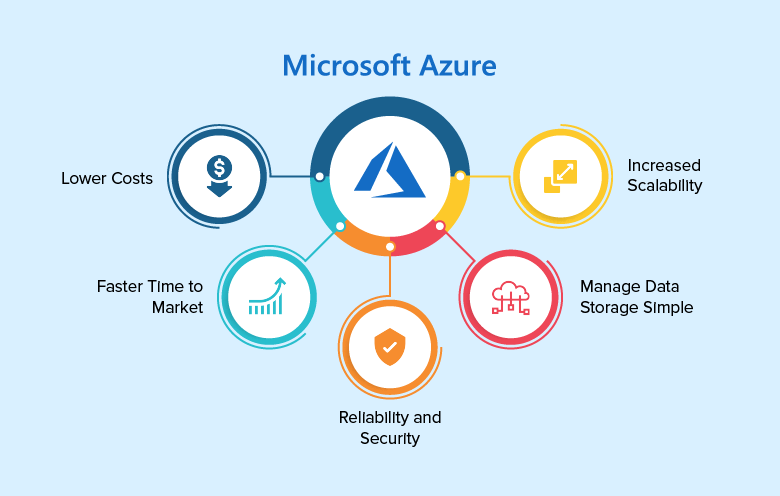How Microsoft's Cloud Solutions Are Transforming Businesses in 2024
Navigating through the complexities of the digital age, businesses are increasingly embracing cloud computing as a source of innovation and efficiency. Leading the charge in this transformative journey, Microsoft's Azure and SharePoint platforms are becoming indispensable for companies looking to boost their operational prowess and carve out a competitive edge. This deep dive into cloud migration underscores the critical role of Microsoft's cloud solutions in navigating towards a brighter digital future. By dissecting the latest trends in cloud computing, breaking down the essentials of cloud migration, and illuminating the transformative effects of Azure and SharePoint, our goal is to arm businesses with the knowledge they need to confidently step into their digital transformation journey in 2024.

Trends in Cloud Computing for 2024
As we move through 2024, the cloud computing landscape is continuously morphing, unveiling new opportunities and hurdles for businesses. Key trends within the Microsoft Azure ecosystem, in particular, are moulding the future of digital business strategies. Grasping these trends is vital for companies eager to tap into cloud technology for their growth and innovation.
Firstly, the emphasis on environmental sustainability is more pronounced than ever, with Microsoft Azure leading the charge. Through its green computing initiatives and sustainable cloud solutions, Azure is helping businesses reduce their carbon footprint and align with worldwide sustainability goals. This focus is not just about being eco-friendly but also about ensuring businesses can meet their environmental responsibility goals.
Another significant trend is the integration of AI and Machine Learning ML into cloud services, which is transforming how businesses operate. Azure's advanced AI and ML capabilities are enabling organisations to streamline their processes, derive deeper insights from their data, and make more informed decisions. This revolution in business operations is fostering innovation and helping companies maintain a competitive edge in their respective sectors.
The expansion of the Internet of Things (IoT) and the increasing demand for real-time data processing have highlighted the importance of edge computing. Azure's edge computing solutions are designed to minimise latency and enhance efficiency by processing data closer to where it is generated. This approach enables businesses to make faster and more informed decisions, leveraging real-time data analytics to drive strategic actions.
Furthermore, the adoption of hybrid and multi-cloud strategies is becoming increasingly important for businesses seeking flexibility and resilience in their cloud computing environments. Many are turning to Azure to seamlessly integrate various cloud environments, enhancing their ability to adapt to changing needs, optimise infrastructure costs, and ensure continuous operation.
Lastly, with the growing sophistication of cyber threats, the focus on security and compliance has never been more critical. Azure is at the forefront of this, providing robust security measures and compliance solutions to protect business data. This commitment to security reassures businesses of the trustworthiness and reliability of their cloud infrastructure.
These trends collectively underscore the dynamic nature of cloud computing in 2024 and highlight the strategic advantages offered by Microsoft Azure for businesses aiming to innovate and expand. By staying informed about and adapting to these trends, companies are better positioned to thrive in the digital era.
The Essentials of Cloud Migration
Cloud migration is a strategic leap for businesses aiming to capture the digital economy's benefits. It involves moving data, applications, and IT processes from on-premises infrastructure to the cloud, significantly boosting operational efficiency, scalability, and innovation. As organisations consider transitioning to cloud platforms like Microsoft Azure, understanding the core elements of this process is crucial.
The decision to migrate to the cloud is driven by the need for businesses to be more agile, responsive, and adaptable to changing market dynamics. Cloud migration offers the flexibility to scale IT resources on-demand, ensuring businesses can efficiently manage workloads and adapt to growth without the constraints of physical infrastructure.

Key Benefits of Migrating to Microsoft Azure:
- Enhanced Scalability: Azure provides the ability to scale resources up or down based on real-time demands, allowing businesses to optimise costs and performance.
- Robust Security Features: With Azure, companies benefit from Microsoft's comprehensive security protocols, including advanced threat detection, data encryption, and a wide range of compliance certifications, ensuring data is securely managed and protected.
- Innovation at Scale: Azure's integration of AI, machine learning, and IoT services enables businesses to innovate and develop new services and products, driving competitive advantage and market leadership.
- Cost Efficiency: Transitioning to Azure helps businesses reduce upfront capital expenditure on hardware and shift to a more predictable, pay-as-you-go pricing model, significantly lowering IT costs.
A successful cloud migration necessitates thorough planning and execution. Businesses should assess their current IT setup, identify movable applications and workloads, and choose the most fitting migration strategy. Tools like Azure Migrate aid in evaluating compatibility and planning, ensuring a smooth transition. Partnering with experienced professionals who understand Azure's nuances can provide invaluable expertise and support, helping businesses maximise their cloud investment.
As companies embark on their cloud migration journey, shifting to Microsoft Azure offers a transformative opportunity to enhance agility, innovation, and competitiveness in the digital era. Concentrating on cloud migration essentials allows companies to ensure a smooth transition that aligns with their strategic goals.
Microsoft Azure: The Backbone of Digital Transformation
In the quest for digital transformation, Microsoft Azure stands out as a crucial platform, offering a broad array of services that empower businesses to innovate, scale, and stay competitive in the rapidly evolving digital market. Azure's comprehensive cloud solutions ease the transition to the cloud, enabling organisations to leverage digital technology and transform their operations.
The versatility of Azure is showcased through its wide range of services, including computing, networking, databases, analytics, AI, and IoT capabilities. This array of services allows businesses of all sizes and industries to tailor solutions to their specific needs, enhancing efficiency and fostering innovation. The global network of Azure data centers guarantees dependable performance and scalability, empowering companies to confidently expand their digital footprint.
Leading the way in AI and IoT integration, Azure equips businesses with the tools necessary to develop intelligent solutions. Through services such as machine learning, cognitive services, and bot services, it automates processes, extracts insights from data, and elevates customer experiences. Azure's IoT solutions also enable device connections, real-time data analysis, and improvements in operational efficiency, paving the way for new opportunities for innovation and growth.
Acknowledging the diverse IT landscapes of today's businesses, Azure delivers robust hybrid cloud solutions. These solutions allow for the seamless integration of on-premises data centers with the cloud, providing the flexibility needed to meet data residency, latency, or regulatory requirements while still benefiting from cloud scalability and innovation.
Security and compliance are paramount for Azure, which establishes a secure foundation for businesses undergoing digital transformation. With built-in security features, comprehensive compliance offerings, and proactive threat management, Azure ensures that data is well-protected across all services, thereby promoting a culture of innovation.
Furthermore, Azure supports seamless integration with existing on-premises systems and software, making the cloud transition as smooth as possible. Its compatibility with Microsoft software, along with support for a wide range of third-party applications and operating systems, means businesses can continue to leverage their existing investments while moving forward with cloud technologies.
SharePoint Online for Enhanced Collaboration
The importance of effective collaboration and seamless information sharing cannot be overstated for achieving business success. Within the Microsoft cloud ecosystem, SharePoint Online stands out as a key enabler of collaboration and productivity enhancements for organisations. By integrating closely with Microsoft 365, it provides a robust solution encompassing document management, team collaboration, and intranet services, making it an indispensable tool for businesses moving to the cloud.
One of the core strengths of SharePoint Online is its ability to centralise document management. It acts as a singular repository for storing, sharing, and managing documents across an organisation. This centralisation not only supports version control but also facilitates real-time collaboration, ensuring that team members always have access to the most current information. This approach significantly boosts efficiency and minimises the risks associated with data duplication.
Further enhancing collaboration, SharePoint Online allows for the creation of dedicated sites for specific projects, teams, or departments. These sites serve as collaborative workspaces where users can share resources, updates, and ideas effortlessly. The seamless integration with Microsoft Teams amplifies this collaborative experience, enabling fluid communication and teamwork within the familiar environment of Microsoft 365.
Customisation and integration capabilities are another highlight of SharePoint Online, offering extensive options to tailor sites to meet the unique needs of any business. Whether it's custom themes, templates, or workflows, organisations have the flexibility to personalise their SharePoint environment. The platform's deep integration with other Microsoft services, such as Power Automate for workflow automation and Power BI for business analytics, further extends its functionality, allowing businesses to craft highly productive and efficient digital workspaces.
Security and compliance are paramount in SharePoint Online, with a suite of robust features designed to safeguard sensitive information. Advanced data loss prevention, encryption, and access controls are just some of the tools at disposal to protect data. Its adherence to global standards and regulations reassures businesses of its capability to handle data securely, providing peace of mind in today's complex regulatory landscape.
Moreover, SharePoint Online's mobile-friendly design ensures that team members can access documents, collaborate, and stay connected from any location, using any device. This level of accessibility and mobility is crucial for supporting remote and hybrid work models, enabling organisations to sustain productivity and collaboration without being hindered by geographical limitations.
Beyond just a document management system, SharePoint Online is a comprehensive platform for fostering collaboration, enhancing productivity, and driving innovation. By leveraging SharePoint Online, businesses are equipped to create a connected and collaborative work environment that not only supports their digital transformation initiatives but also boosts their competitive edge in the digital marketplace.
Navigating Your Cloud Migration to Azure and SharePoint

The transition to cloud computing, particularly to platforms like Microsoft Azure and SharePoint Online, is a strategic journey that can redefine a business's operational landscape. This migration not only promises enhanced efficiency, scalability, and innovation but also introduces complexities that require careful planning and execution. Here's a structured guide to navigating your cloud migration journey effectively:
Initial Assessment and Strategy Development:
- Begin with a comprehensive assessment of your current IT infrastructure, applications, and data. Identify which components are suitable for cloud migration and prioritise them based on business needs and migration complexity.
- Develop a cloud migration strategy that aligns with your business objectives. Consider factors such as cost, performance, security, and compliance requirements. Microsoft's Azure Migrate tool can be instrumental in this phase, offering insights and recommendations for a smooth transition.
Choosing the Right Migration Approach:
- Decide on the best migration approach for each application or workload. Options include rehosting (lift-and-shift), refactoring, rearchitecting, or rebuilding, depending on the specific needs and goals.
- Rehosting can be a quick and cost-effective way to move to the cloud, while refactoring or rearchitecting may offer more significant benefits in terms of scalability, performance, and cost savings in the long run.
Security and Compliance Considerations:
- Security should be a top priority throughout the migration process. Leverage Azure's advanced security features to protect your data and applications in the cloud.
- Ensure compliance with industry standards and regulations by utilising Azure's comprehensive compliance offerings. Conduct regular security and compliance assessments to maintain a robust security posture.
Implementation and Migration Execution:
- Execute the migration according to the planned approach, leveraging tools and services like Azure Migrate and SharePoint Migration Tool for a seamless transition.
- Consider a phased migration to minimise disruptions to business operations. Start with less critical workloads to test the migration process and gradually move more critical applications.
Post-Migration Optimisation and Training:
- After migration, optimise your cloud environment for cost, performance, and security. Azure Cost Management and Azure Advisor can provide valuable insights for ongoing optimisation.
- Provide training and support to your staff to ensure they are equipped to leverage the new cloud environment effectively. Adoption of new tools and technologies can be facilitated through workshops, online training, and documentation.
Partnering with Experts:
- Engaging with Microsoft-certified partners can offer additional expertise and support throughout your migration journey. These partners can provide tailored advice, technical expertise, and best practices to ensure a successful migration.
Navigating the cloud migration journey to Microsoft Azure and SharePoint requires strategic planning, careful execution, and ongoing optimisation. By following these steps, businesses can maximise the benefits of cloud computing, paving the way for enhanced innovation, scalability, and competitiveness in the digital era.
Conclusion
The shift towards cloud computing, with Microsoft Azure and SharePoint Online leading the way, marks a transformative leap for businesses navigating the complexities of the digital age. While challenging, this journey opens up unparalleled opportunities for growth, agility, and innovation. Understanding the latest trends in cloud computing, the essentials of cloud migration, Azure's comprehensive capabilities, and SharePoint Online's collaborative power equips businesses to confidently embark on this transformative journey.
Digital transformation is no longer optional but a necessity in today's fast-paced business landscape. Microsoft's cloud solutions provide the necessary tools and technologies for companies to stay competitive, meet evolving customer expectations, and thrive in the digital marketplace. The journey to the cloud may vary for each business, but the destination remains the same: a future-proof, scalable, and innovative digital infrastructure.
As we look towards the future, the importance of strategic planning, careful execution, and continuous optimisation cannot be overstated. Businesses that embrace these principles, leveraging the full potential of Microsoft Azure and SharePoint Online, will not only navigate digital transformation successfully but will emerge as leaders in their respective industries.
The path to digital excellence is fraught with challenges, but with the right approach, guidance, and tools, your business can achieve remarkable success. We encourage you to take the next step in your cloud migration journey with confidence, knowing that the benefits of digital transformation are within reach.
